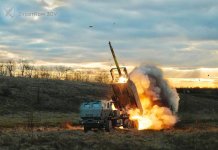If claims from the Indian media are to be believed, then about 40 percent of Chinese-origin JF-17 fighters in two Pakistan Air force bases are reportedly grounded for a variety of reasons.
Quoting ‘government sources,’ India’s Times Now reports that there are problems with the fuselage of the fighters, with cracks being detected in the lower fairing skin, an area that is most affected by G or gravity-related pressures.
JF-17 has been the hallmark of Pakistan’s defense innovation, with many countries expected to buy the fighter jet. According to the report, the fighter’s canopy electrical system is malfunctioning, a fault that can make ejection by a pilot difficult in case of an emergency.
The J-17s are also believed to have developed problems with fuselages, with cracks being detected in the lower fairing skin. “There have been cracks in the strake areas, which could be in the fuselage or wings. A strake is a strengthening device and again, this could be because of stress during flying,” the Indian report adds.
Refuting the reports, Islamabad-based defense analyst Shahid Raza said Indian media has posted a falsified “source-based” news item.
“As far as the PAF is concerned, my understanding is that PAF maintains a “Red Alert” status 365 days of the year. That means that PAF considers itself to be at war all the time,” he told EurAsian Times.

He said the PAF’s fleet availability is extremely high, as the force maintains a higher Pilot-Cockpit ratio and better Turnaround Time than IAF. “Both of these elements of readiness can’t be achieved without a high fleet availability rate.”
The JF-17 is a joint Pakistani-Chinese fighter jet, inaugurated by the Chengdu Aircraft Corporation (CAC) in the early 1990s as the FC-1, with Pakistan later joining as the full partner.
China supports the avionics and radar of the plane, among many other critical technologies, with Pakistan producing 58% of the fighter’s airframe and subsystems, which includes the wings, tail, and forward fuselage sections. The fighter jet is assembled in Pakistan.
Producing the fighter jets indigenously has one important advantage – you don’t have to rely on foreign spare parts or aircraft upgrades. This is what sets the PAF’s combat preparedness apart from countries like India whose frontline fighters are mainly foreign-based and require outside help.
“Another key element to understand is that PAF has dedicated factories for providing ongoing MRO services for every single aircraft in service, down to UAVs. Even PAF F-16s are rarely sent overseas for maintenance,” Raza added.
The Indian media also quoted the anchor breakage issues in the JF-17 fighter, which shows signs of structural weakness. Although the reports are unconfirmed, EurAsian Times reached out for comment to multiple authorities in Pakistan who refused to comment. The news was also widely posted on Indian social media accounts.
40% of Pakistan's JF 17 fighter jets are grounded for a various reasons. Cracks being detected in the lower fairing skin, perhaps structural cracks due with 'G' forces. Ejection seat and Electrical system issues. Fleet grounded https://t.co/3DxQDlp4Vn
— Aviator Anil Chopra (@Chopsyturvey) November 3, 2020
JF-17s have only been sold to Nigeria and Myanmar so far, with talks for sale happening with Sri Lanka, Sudan, Malaysia, and Zimbabwe in recent years. The Pakistan air force continues to be the biggest customer of the plane so far, with about 150 units already in service with the force.
The fighter uses the RD-93 engine, and some reports suggest Pakistan may use the Russia-developed enhanced version of the engine – RD-93MA, which is a modification of the RD-93 engine.
The RD-93MA engine has the capacity to produce a maximum thrust of 9,300 kgf (kilogram-force), which is significantly greater than the existing RD-93 engine with a maximum thrust of 8,300kgf.
Pakistan and China are now producing a new version of the JF-17, designated the Block 3 which will see the JF-17’s information-based warfare capability and weapons upgraded. This upgraded JF-17 made its first flight in December 2019. The countries have ramped up the production of the plane to unprecedented levels this year.
As per EurAsian Times report, the latest, powered-up version of the JF-17 fighter jet reportedly features technologies from China’s high-end J-20 fighter jet that will immensely boost its combat efficiency. The deployment of the AESA (Active electronically scanned array) is also a key upgrade to the older version radar, which has already been selected from a Chinese manufacturer.




